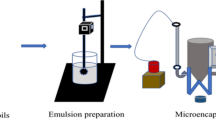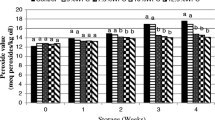Abstract
With an increased awareness of the link between the consumption of omega 3-6-9 fatty acid-rich oils and health, the food industry has been developing innovative strategies for raising their levels within the diet. Microencapsulation is one approach used to protect those oils from oxidative deterioration and to improve their ingredient properties (e.g., handling and sensory). Spray drying is the most commonly used technique to develop microcapsules. The preparation of protein-stabilized emulsions is a fundamental step in the process in order to produce microcapsules with good physical properties, effective protection and controlled release behaviors. This review describes types of emulsions prepared by animal and plant proteins, discusses the relationship between emulsion properties and microcapsule properties, and identifies key parameters to evaluate physical properties (e.g., moisture content, water activity, particle size, surface oil and entrapment efficiency), oxidative stability and release behavior of spray-dried microcapsules for industrial application.

(Reproduced with permission from Raybaudi-Massilia and Mosqueda-Melgar 2012)
Similar content being viewed by others
References
Aberkane L, Roudaut G, Saurel R (2014) Encapsulation and oxidative stability of PUFA-rich oil microencapsulated by spray drying using pea protein and pectin. Food Bioprocess Technol 7:1505–1517
Aghbashlo M, Mobli H, Madadlou A, Rafiee S (2013) Fish oil microencapsulation as influenced by spray dryer operational variables. Int J Food Sci Technol 48:1707–1713
Avramenko NA, Low NH, Nickerson MT (2013) The effects of limited enzymatic hydrolysis on the physicochemical and emulsifying properties of a lentil protein isolate. Food Res Int 51:162–169
Avramenko NA, Chang C, Low NH, Nickerson MT (2016) Encapsulation of flaxseed oil within native and modified lentil protein-based microcapsules. Food Res Int 81:17–24
Bakry AM, Abbas S, Ali B, Majeed H, Abouelwafa MY, Mousa A, Liang L (2016) Microencapsulation of oils: a comprehensive review of benefits, techniques, and applications. Compr Rev Food Sci Food Saf 15:143–182
Can Karaca A, Low N, Nickerson M (2011) Emulsifying properties of chickpea, faba bean, lentil and pea proteins produced by isoelectric precipitation and salt extraction. Food Res Int 44:2742–2750
Can Karaca A, Low N, Nickerson M (2013) Encapsulation of flaxseed oil using a benchtop spray dryer for legume protein-maltodextrin microcapsule preparation. J Agric Food Chem 61:5148–5155
Can Karaca A, Low NH, Nickerson MT (2015) Potential use of plant proteins in the microencapsulation of lipophilic materials in foods. Trends Food Sci Technol 42:5–12
Chang C, Tu S, Ghosh S, Nickerson MT (2015) Effect of pH on the inter-relationships between the physicochemical, interfacial, and emulsifying properties of pea, soy, lentil and canola protein isolate. Food Res Int 44:360–367
Chang C, Varankovich N, Nickerson MT (2016) Microencapsulation of canola oil by lentil protein isolate-based wall materials. Food Chem 212:264–273
Chen W, Wang H, Zhang K, Gao F, Chen S, Li D (2016) Physicochemical properties and storage stability of microencapsulated DHA-rich oil with different wall materials. Appl Biochem Biotechnol 179:1129–1142
Cooper CL, Dubin PL, Kayitmazer AB (2005) Polyelectrolyte-protein complex. Curr Opin Colloid Interface Sci 10:52–78
Cournarie F, Savelli M, Rosilio V, Bretez F, Vauthier C, Grossiord J et al (2004) Insulin-loaded W/O/W multiple emulsions: comparison of the performances of systems prepared with medium-chain-triglycerides and fish oil. Eur J Pharm Biopharm 58:477–482
da Silva PT, Fries LLM, de Menezes CR, Holkem AT, Schwan CL, Wigmann CL et al (2014) Microencapsulation: concepts, mechanisms, methods and some applications in food technology. Cienc Rural 44:1304–1311
Damodaran S (2005) Protein stabilization of emulsions and forms. J Food Sci 40:R54–R66
Desai KGH, Park HJ (2005) Recent developments in microencapsulation of food ingredients. Dry Technol 23:1361–1394
Drusch S (2006) Sugar beet pectin: a novel emulsifying wall component for microencapsulation of lipophilic food ingredients by spray-drying. Food Hydrocoll 21:1223–1228
Drusch S, Mannino S (2009) Patent-based review on industrial approaches for the microencapsulation of oils rich in polyunsaturated fatty acids. Trends Food Sci Technol 20:237–244
Encina C, Vergara C, Gimenez B, Oyarzun-Ampuero F, Robert P (2016) Conventional spray-drying and future trends for the microencapsulation of fish oil. Trends Food Sci Tech 56:46–60
Ezhilarasi PN, Karthik P, Chhanwal N, Anandharamakrishnan C (2013) Nanoencapsulation techniques for food bioactive components: a review. Food Bioprocess Technol 6:628–647
Gallardo G, Guida L, Martinez V, Lopez MC, Bernhardt D, Blasco R et al (2013) Microencapsulation of linseed oil by spray drying for functional food application. Food Res Int 52:473–482
Ghasemi S, Abbasi S (2014) Formation of natural casein micelle nanocapsule by means of pH changes and ultrasound. Food Hydrocoll 42:42–47
Gokmen V, Mogol BA, Lumaga RB, Fogliano V, Kaplun Z, Shimoni E (2011) Development of functional bread containing nanoencapsulated omega-3 fatty acids. J Food Eng 105:585–591
Goyal A, Sharma V, Sihag MK, Tomar SK, Arora S, Sabikhi L et al (2015) Development and physico-chemical characterization of microencapsulated flaxseed oil powder: a functional ingredient for omega-3 fortification. Powder Technol 286:527–537
Hee YY, Tan CP, Rahman RA, Adzahan NM, Lai WT, Chong GH (2015) Influence of different wall materials on the microencapsulation of virgin coconut oil by spray drying. Int J Food Eng 11:61–69
Hogan SA, McNamee BG, O’Riordan ED, O’Sullivan M (2001) Microencapsulating properties of whey protein concentrate 75. J Food Sci 66:675–680
Jimenez-Martin E, Rojas TA, Gharsallaoui A, Carrascal JR, Perez-Palacios T (2016) Fatty acid composition in double and multilayered microcapsules of ω-3 as affected by storage conditions and type of emulsions. Food Chem 194:476–486
Kaushik P, Dowling K, Barrow CJ, Adhikari B (2015) Microencapsulation of omega-3 fatty acids: a review of microencapsulation and characterization methods. J Funct Food 19:868–881
Kha TC, Nguyen MH, Roach PD, Stathopoulos CE (2014) Microencapsulation of gac oil: optimisation of spray drying conditions using response surface methodology. Powder Technol 264:298–309
Klinkersorn U, Sophanodora P, Chinachoti P, McClements D, Decker EA (2005) Stability of spray-dried tuna oil emulsion encapsulated with two-layered interfacial membranes. J Agric Food Chem 53:8365–8371
Koc M, Gungor O, Zungur A, Yalcin B, Selek I, Ertekin FK, Otles S (2015) Microencapsulation of extra virgin olive oil by spray drying: effect of wall materials composition, process conditions, and emulsification method. Food Bioprocess Technol 8:301–318
Kochhar SP, Henry CJK (2009) Oxidative stability and shelf-life evaluation of selected culinary oils. Int J Food Sci Nutr 60:289–296
Konan YN, Gurny R, Allemann E (2002) Preparation and characterization of sterile and free-dried sub-200 nm nanoparticles. Int J Pharm 233:239–252
Kwamman Y, Klinkesorn U (2015) Influence of oil load and maltodextrin concentration on properties of tuna oil microcapsules encapsulated in two-layer membrane. Dry Technol 33:854–864
Liang HN, Tang CH (2013a) pH-dependent emulsifying properties of pea [Pisum sativum (L.)] proteins. Food Hydrocoll 33:309–319
Liang HN, Tang CH (2013b) Emulsifying and interfacial properties of vicilins: role conformational flexibility at quaternary and/or tertiary levels. J Agric Food Chem 61:11140–11150
Martinez ML, Curti MI, Roccia P, Llabot JM, Penci MC, Bodoira RM et al (2015) Oxidative stability of walnut (Juglans regia L.) and chia (Salvia hispanica L.) oils microencapsulated by spray drying. Powder Technol 270:271–277
McClements DJ (2005) Emulsion ingredients. In: Clydesdale FM (ed) Food emulsions: principles, practices, and techniques, 2nd edn. CRC Press, Boca Raton, pp 95–174
McClements DJ, Decker EA (2007) Lipids. In: Damodaran S, Parkin KL, Fennema OR (eds) Food chemistry, 4th edn. CRC Press, Boca Raton, pp 155–216
McClements DJ, Decker EA, Weiss J (2007) Emulsion-based delivery systems for lipophilic bioactive components. J Food Sci 72:R109–R124
McNamee BF, O’Riorda ED, O’Sullivan M (1998) Emulsification microencapsulation properties of gum Arabic. J Agric Food Chem 46:4551–4555
Nesterenko A, Alric I, Silvestre F, Durrieu V (2012) Influence of soy protein’s structural modifications on their microencapsulation properties: α-tocopherol microparticle preparation. Food Res Int 48:387–396
Nesterenko A, Alric I, Silvestre F, Durrieu V (2013) Vegetable proteins in microencapsulation: a review of recent interventions and their effectiveness. Ind Crop Prod 42:469–479
Ng SK, Lau Jessie LY, Tan CY, Long K, Nyam KL (2013) Effect of accelerated storage on microencapsulated kenaf seed oil. J Am Oil Chem Soc 90:1023–1029
Nickerson M, Yan C, Cloutier S, Zhang W (2014) Protection and masking of omega-3 and -6 oils via microencapsulation. In: Gaonkar AG, Vasisht N, Khare AR, Sobel R (eds) Microencapsulation in food industry. Elsevier Inc., San Diego, pp 485–500
Piacentini E, Giorno L, Dragosavac MM, Vladisavljevic GT, Holdich RG (2013) Microencapsulation of oil droplets using cold water fish gelatin/gum Arabic complex coacervation by membrane emulsification. Food Res Int 53:362–372
Pourashouri P, Shabanpour B, Razavi SH, Jafari SM, Shabani A, Aubourg SP (2014a) Impact of wall materials on physicochemical properties of microencapsulated fish oil by spray drying. Food Bioprocess Technol 7:2354–2365
Pourashouri P, Shabanpour B, Razavi SH, Jafari SM, Shabani A, Aubourg SP (2014b) Oxidative stability of spray-dried microencapsulated fish oils with different wall materials. J Aquat Food Prod Technol 23:567–578
Rascon MP, Beristain CI, Garcie HS, Salgado MA (2010) Carotenoid retention and storage stability of spray-dried paprika oleoresin using gum Arabic and soy protein isolate as wall materials. LWT Food Sci Technol 44:549–557
Ray S, Raychaudhuri U, Chakraborty R (2016) An overview of encapsulation of active compounds used in food products by drying technology. Food Biosci 13:76–83
Raybaudi-Massilia RM, Mosqueda-Melgar J (2012) Polysaccharides as carriers and protectors of additives and bioactive compounds in foods. In: Desiree NK (ed) The complex word of polysaccharides. InTech, Rijeka, pp 429–453
Rosenberg M, Kopelman IJ, Talmon Y (1990) Factors affecting retention in spray-drying microencapsulation of volatile materials. J Agric Food Chem 38:1288–1294
Sikorski ZE (2001) Functional properties of proteins in food systems. In: Sikorski ZE (ed) Chemical and functional properties of food proteins. CRC Press, Boca Raton, pp 113–135
Takeungwongtrakul S, Benjakul S, H-kittikun A (2015) Wall materials and the presence of antioxidants influence encapsulation efficiency and oxidative stability of microencapsulated shrimp oil. Eur J Lipid Sci Technol 117:450–459
Tamm F, Harter C, Brodkorb A, Drusch S (2016a) Functional and antioxidant properties of whey protein hydrolysate/pectin complexes in emulsions and spray-dried microcapsules. LWT Food Sci Technol 73:524–527
Tamm F, Herbst S, Brodkorb A, Drusch S (2016b) Functional properties of pea protein hydrolysates in emulsions and spray-dried microcapsules. Food Hydrocoll 58:204–214
Tang CH, Li XR (2013) Microencapsulation properties of soy protein isolate: influence of preheating and/or blending with lactose. J Food Eng 117:281–290
Tur JA, Bibiloni MM, Sureda A, Pons A (2012) Dietary sources of omega-3 fatty acids: public health risks and benefits. Br J Nutr 107:23–52
Velasco J, Dobarganes C, Marquez-Ruiz G (2003) Variables affecting lipid oxidation in dried microencapsulated oils. Grasas Aceites 54:304–314
Xiao JX, Yu HY, Yang JA (2011) Microencapsulation of sweet orange oil by complex coacervation with soybean protein isolate/gum Arabic. Food Chem 125:1267–1272
Yu C, Wang W, Yao H, Liu H (2007) Preparation of phospholipid microcapsules by spray drying. Dry Technol 25:695–702
Zhao XH, Tang CH (2016) Spray-drying microencapsulation of CoQ10 in olive oil for enhanced water dispersion, stability and bioaccessibility: influence of type of emulsifiers and/or wall materials. Food Hydrocoll 61:20–30
Acknowledgements
Financial support for the research was kindly supported by the Saskatchewan Ministry of Agriculture and the Canada-Saskatchewan Growing Forward 2 Bi-lateral Agreement (ADF # 2015-0274) and the Saskatchewan Pulse Growers.
Author information
Authors and Affiliations
Corresponding author
Rights and permissions
About this article
Cite this article
Chang, C., Nickerson, M.T. Encapsulation of omega 3-6-9 fatty acids-rich oils using protein-based emulsions with spray drying. J Food Sci Technol 55, 2850–2861 (2018). https://doi.org/10.1007/s13197-018-3257-0
Revised:
Accepted:
Published:
Issue Date:
DOI: https://doi.org/10.1007/s13197-018-3257-0




